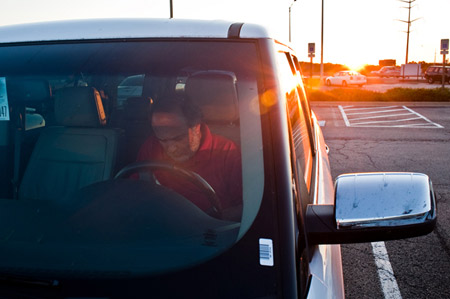
Joe Klein in the 'Fridge' before he started having car trouble. Photograph by Peter van Agtmael - Magnum for TIME
Denver, Co.
Traveling Companions: none
Event: Swapping Out the Fridge
I sensed the Fridge was having trouble in Kansas City when the low tire pressure light came on. So, with the help of Paul Bohr–a great old guy with whom I had coffee and muffins made by his wife, Dorothy–I filled it. Then the low pressure light came on again in Nebraska. This time, I inspected the rear left wheel more carefully and found a nail sticking in the sidewall. I contacted Hertz, and told them of the mythic importance the Fridge had achieved on this trip; Hertz said all I had to do was go to a specific tire store in Denver and get the thing replaced. Easier said than done. The tire store said all four tires needed to be changed simultaneously, lest some bad, unbalanced tire karma be visited upon the vehicle. This, Hertz would not do. “We’re gonna have to swap you out,” the woman on the phone said cheerfully.
Arrgh. I started this hejira with the Fridge and wanted to end with it. My dismay was compounded, a bit, when the new car turned out to be maroon Mazda Something–not quite the harrowing whiteness and humongitude of the Ford Flex; comparatively sporty, but entirely anonymous, in fact. And foreign. I liked the idea of driving an American car across America. But that raised a question: how American was the Fridge? I was reminded of the brunch I had with first-responders in Brighton, Mi…and the firecracker autoworker, Tammy Jackson, who won’t allow foreign cars in her driveway. But what’s a foreign car? “I’ve got a Honda,” said a firefighter named Tanya at the Brighton brunch. “The whole thing is made in the United States. I’ve been looking at a Ford Fiesta, which is assembled in Mexico. You tell me which one is foreign, ok?”
This is an interesting question. One thing I’ve started thinking about in a big way on this trip is the evaporation of American manufacturing. It’s a story I’ve been covering since my days at Rolling Stone in the mid-1970s, when I spent a fair amount of time around the collapsing steel industry on the southeast side of Chicago. I bought the idea of global competitive advantages–that we’d just move up the food chain, toward more high-tech and brainpower jobs, that our schools would meet the challenge of educating workers for the new digital world, and that we’d benefit from the lower prices that imported goods would bring to the market. I’ve not owned an American-brand car in 15 years; it just didn’t seem a matter of importance. In any case, the American cars were big, badly-built gas guzzlers. Right now, I own a Toyota Camry hybrid, which is a great car.
But I’m not feeling so comfortable about that anymore. And that is why my swap-out today has left me feeling blue: I think this whole experiment in untrammeled globalism may have to be rethought. I don’t see any flood of new jobs, new industries developing; I don’t see much evidence that our schools can turn the muscle-laborers of the past into knowledge workers. I wonder what would be more healthy for our society: lower prices at Wal-Mart or a renewal of American manufacturing in crucial industries like automobiles, computers and steel that might raise prices some, but also yield a prouder, less freaked out populace. I don’t have a definitive answer about that yet. But it’s on my mind–and while I know that most foreign cars on the road here are as American as the American cars, driving an American car is a statement of something that suddenly seems important: a belief in American manufactures.
Meanwhile, farewell Fridge…may we meet again when Ford develops a plug-in hybrid model. And what on earth should I nickname my Maroon Mazda?
This post is part of my Election Road Trip 2010 project. To track my location across the country, and read all my road trip posts, click here.


